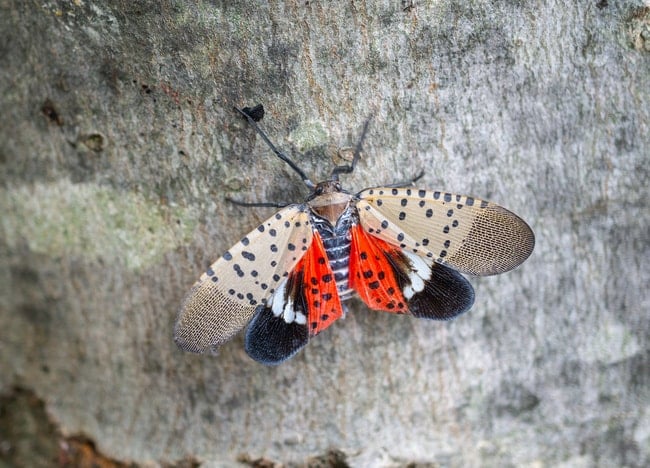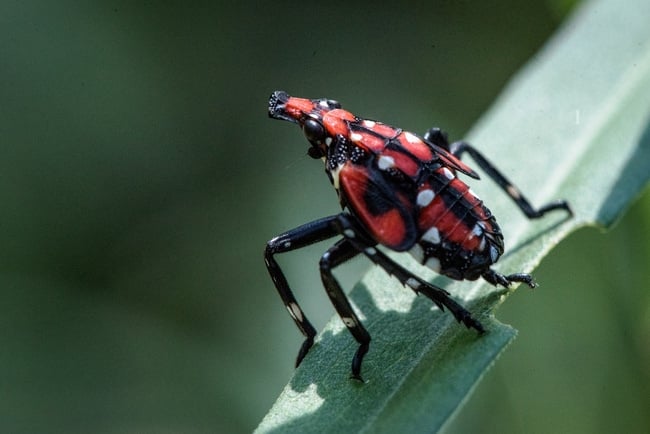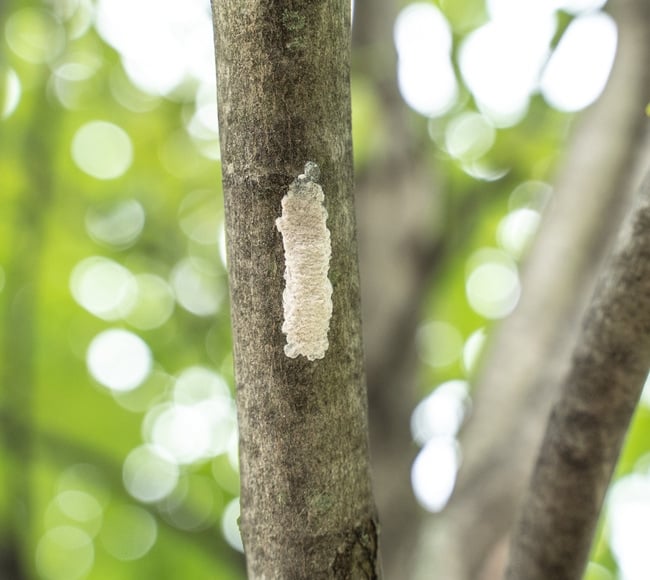The Notorious Spotted Lanternfly: How To Slow The Spread

You have most likely seen or heard of the notorious Spotted Lanternfly that is destroying crops and fruit trees nationwide. There are a couple of simple ways that you can help slow the spread. One way is to destroy their eggs in the fall (before they hatch in May). Learn what signs to look for and other important details about this threatening pest. Read on!
Why The Spotted Lanternfly Is So Dangerous
The Spotted Lanternfly has been on the Agricultural Department’s Most Wanted List all summer. These black and red bugs, with distinctive spots, have spread like wildfire in the Northeast and Midwest, destroying crops and fruit trees, becoming an agricultural threat.
They feed on the sap of cash crops such as grapes (which threatens California’s wine country), apples, peaches, and a variety of trees. Don’t be fooled by this bite-less and sting-free insect. Their sucking mouth feeds on plants—causing wilting and dieback of host plants, reducing crop quality and yield. To make the situation worse, as they feed, they secrete a sugary substance called “honeydew,” aiding in growth of black sooty mold, which can attract additional pests, furthering damage to trees.
History
First spotted in the United States in 2014 in Pennsylvania, experts believe they arrived on a shipment from China a couple of years prior and have since spread to over a dozen states. Residents in the Northeast and Midwest have been besieged by infestations of the spotted lanternfly. With no natural predators in the United States, they have quickly spread to suburbia and urban areas and have been witnessed swarming on the sides of tall buildings. They are not strong flyers, therefore they seem to climb tall structures and “hop” or glide downward into air currents to get closer to the trees they feed on.
How To Do Damage Control
During the summer months, many people encourage others to kill these nuisances on sight, but this likely won’t put a dent in their exploding population. These pests are very good at reproducing.
Frigid temperatures kill adult spotted lanternflies, bringing temporary relief for some, but don’t celebrate quite yet. Spotted Lanternflies mate and lay eggs through October and November and will continue reproducing until the first hard freeze.
Before they die off, they deposit eggs that remain intact through the winter. Tiny nymphs hatch as weather warms, threatening additional trees and crops.
Experts encourage destroying clusters of eggs in the fall, winter, and early spring before hatching begins in May.

What Do Eggs Look Like?
During the fall, Spotted Lanternflies deposit their eggs in masses on the sides of trees, pallets, firewood, outdoor furniture, and other flat objects. Egg masses begin by looking like small spots of gray, putty-like material with a waxy coating.
Over time, they darken to resemble dried mud or mold on a tree. Egg sacs can also resemble tire tracks. Each mass contains 30-50 eggs.

How To Dispose Of Eggs In Fall And Winter
Stomping out single adults one at a time is all well and good, but the goal is to eliminate the egg masses, so we don’t have to battle with the adults. The fall and winter is the time to do this. Homeowners should walk around outside checking their property for signs of lanternfly eggs and then destroy them. Check outdoor playsets, toys, garden tools, machinery, and patio furniture before storing them away for the season.
Experts recommend using a rock (or credit card) to crush the egg mass while you scrape it off the tree and into a bag or container. Add a bit of hand sanitizer, rubbing alcohol, or bleach to the bag to kill the eggs before disposing. You can also wrap sticky tape around tree trunks, fence posts, rocks, or wherever these bugs lay eggs and discard once the tape is full and dead. Many experts warn of this method however, since it can also trap other small innocuous creatures. You could add a wire netting or cage around the tape to prevent catching small birds or animals.
Spotted Lanternflies are also efficient hitchhikers, climbing onto clothes, luggage, and cars. When traveling, especially to an area with known infestation, be sure to check yourself and vehicle over for stowaways to ensure you haven’t given one a ride. These pests also like to lay eggs on tires, car bumpers, and grilles, so avoid parking under trees or bushes in areas known to be infested.
Remove The “Tree Of Heaven”
While the Spotted Lanternfly is a serious pest for a variety of trees and agricultural crops, its preferred tree host is the tree-of-heaven, a fast-growing invasive import from China. Other than being a favored food of choice for this pest, this non-native tree is notorious for its extreme adaptability to urban environments and its difficultly to control.
The “Tree of Heaven” is a damaging plant as it crowds out native vegetation and inhibits the growth of neighboring plants. Ridding your yard of this non-native plant will not only benefit your vegetation, but will also eliminate a popular food source for the Spotted Lanternfly.
Learn more about how to control Tree of Heaven in the following video, produced by Penn State Extension:
Collective Action Is Key
While individual combat won’t eradicate the Spotted Lanternfly, collective action can help curb spread and give nature some needed time to catch up. Experts warn that if spread isn’t slowed, they could reach and severely impact California wine country within the next few years.
If you spy a Spotted Lanternfly on your property, inform your state’s Department of Agriculture so they can continue to monitor this vexing insect.
Join The Discussion
Have you ever seen a Spotted Lanternfly before?
Will you be searching your property for their eggs this fall?
Let us know in the comments below!

Natalie LaVolpe
Natalie LaVolpe is a freelance writer and former special education teacher. She is dedicated to healthy living through body and mind. She currently resides on Long Island, New York, with her husband, children, and dog.






I live in nj and the lantern flies are out of control. There are so many eggs in the bushes and tree.they are babies right now. We have electric fly swatter. They have to come up with something to kill them now before they get bigger. The bushes I share with my neighbor I’ve cut down the bushes very short, but I’m doing my part on my side, but if he doesn’t take care of the lanternflys on his side, I just can’t keep up with this someone needs to help us. I’m ready to burn the bushes but can’t do anything because they’re not mine and the tree is not mine. It’s all on his side. Someone please help.
We sure hope your neighbor does his part, for your sake! Best of luck!
A few of the additional gifts from the rotten Communist Chinese Party: Lantern Flies, Tree of Heaven, Covet19. Also Gypsy Moths, Japanese beetles, African honeybees, Killer Hornets, fire ants, pythons, boa constrictors, Tent Caterpillars, Bag Worms, stink bugs, etc, etc,
BAH, HUMBUG. They are all a HUMBUG.
Japanese Tallow trees that we’ve always called Chinaberries drive me nuts ever since I’ve learned they are invasive. Impossible to eradicate them on my property. It’s like a hydra. You cut one, from the stump sprout 20!
I feel that way about Creeping Buttercup. What a beast to get rid of! Good luck in your efforts against your Chinaberry.
My family walks around with fly swatters looking for these guys. We kill them by the thousands.
Why not show picture of tree of heaven, and more pics of eggs. Ones I have seen in NJ don’t look like that. Glad you told of alcohol over egg mass to kill after removal. Many people are just scraping nest off tree.
That’s what I was thinking. They say learn how to tell, and then have one picture and a video. I don’t watch the videos. I would look at 20 pictures though! Different angles, up close, different places, etc.
Helpful article! While I haven’t seen any critters, the Tree of Heaven is quite abundant here in southeastern Va.(Chesapeake/Virginia Beach). I will now be on the lookout for the eggs!
Found a large swarm on my property in Garden MI. Will begin searching for eggs.
Saw dozens in Middletown, New Jersey train station. August.
Reported it and yes one was inside the train going to New York City!
Hi Robert! Yes, the population is exploding. We hope our article gave you helpful information. Thanks for sharing what you saw with us! Please stay in touch by joining our mailing list: https://www.farmersalmanac.com/newsletter
Yikes!